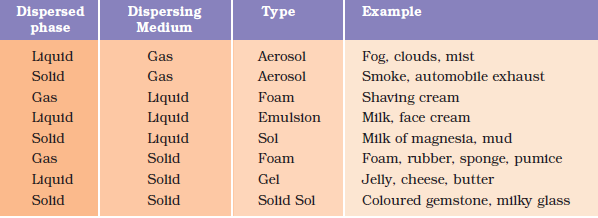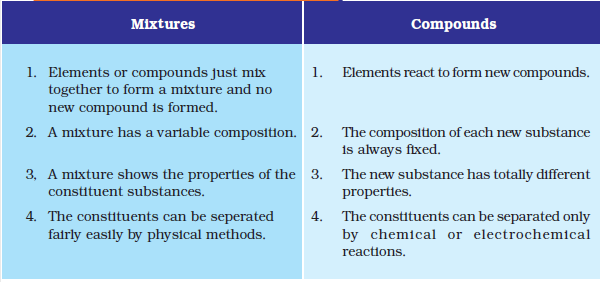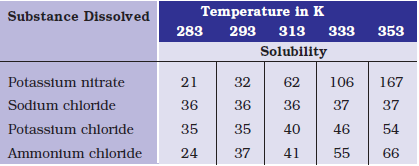Table of Contents

Chapter 2
Is Matter Around Us Pure?
How do we judge whether milk, ghee, butter, salt, spices, mineral water or juice that we buy from the market are pure?
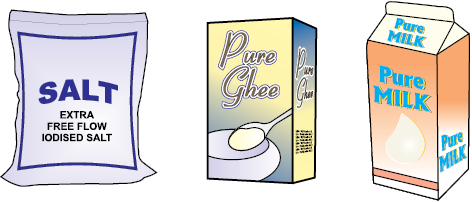
Fig. 2.1: Some consumable items
Have you ever noticed the word ‘pure’ written on the packs of these consumables? For a common person pure means having no adulteration. But, for a scientist all these things are actually mixtures of different substances and hence not pure. For example, milk is actually a mixture of water, fat, proteins etc. When a scientist says that something is pure, it means that all the constituent particles of that substance are the same in their chemical nature. A pure substance consists of a single type of particles. In other words, a substance is a pure single form of matter.
As we look around, we can see that most of the matter around us exist as mixtures of two or more pure components, for example, sea water, minerals, soil etc. are all mixtures.
2.1 What is a Mixture?
Mixtures are constituted by more than one kind of pure form of matter. We know that dissolved sodium chloride can be separated from water by the physical process of evaporation. However, sodium chloride is itself a pure substance and cannot be separated by physical process into its chemical constituents. Similarly, sugar is a substance which contains only one kind of pure matter and its composition is the same throughout.
Soft drink and soil are not single pure substances. Whatever the source of a pure substance may be, it will always have the same characteristic properties.
Therefore, we can say that a mixture contains more than one pure substance.
2.1.1 Types of mixtures
Depending upon the nature of the components that form a mixture, we can have different types of mixtures.
Activity 2.1
• Let us divide the class into groups A, B, C and D.
• Group A takes a beaker containing 50 mL of water and one spatula full of copper sulphate powder. Group B takes 50 mL of water and two spatula full of copper sulphate powder in a beaker.
• Groups C and D can take different amounts of copper sulphate and potassium permanganate or common salt (sodium chloride) and mix the given components to form a mixture.
• Report the observations on the uniformity in colour and texture.
• Groups A and B have obtained a mixture which has a uniform composition throughout. Such mixtures are called homogeneous mixtures or solutions. Some other examples of such mixtures are: (i) salt dissolved in water and (ii) sugar dissolved in water. Compare the colour of the solutions of the two groups. Though both the groups have obtained copper sulphate solution but the intensity of colour of the solutions is different. This shows that a homogeneous mixture can have a variable composition.
• Groups C and D have obtained mixtures, which contain physically distinct parts and have non-uniform compositions. Such mixtures are called heterogeneous mixtures. Mixtures of sodium chloride and iron filings, salt and sulphur, and oil and water are examples of heterogeneous mixtures.
Activity 2.2
• Let us again divide the class into four groups – A, B, C and D.
• Distribute the following samples to each group:
− Few crystals of copper sulphate to group A.
− One spatula full of copper sulphate to group B.
− Chalk powder or wheat flour to group C.
− Few drops of milk or ink to group D.
• Each group should add the given sample in water and stir properly using a glass rod. Are the particles in the mixture visible?
• Direct a beam of light from a torch through the beaker containing the mixture and observe from the front. Was the path of the beam of light visible?
• Leave the mixtures undisturbed for a few minutes (and set up the filtration apparatus in the meantime). Is the mixture stable or do the particles begin to settle after some time?
• Filter the mixture. Is there any residue on the filter paper?
Discuss the results and form an opinion.
• Groups A and B have got a solution.
• Group C has got a suspension.
• Group D has got a colloidal solution.
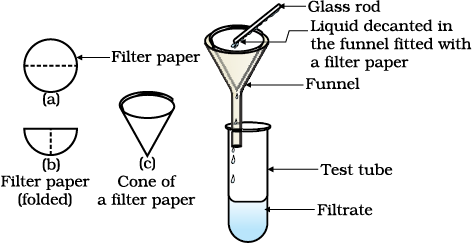
Fig. 2.2: Filtration
Now, we shall learn about solutions, suspensions and colloidal solutions in the following sections.
Questions
1. What is meant by a substance?
2. List the points of differences between homogeneous and heterogeneous mixtures.
2.2 What is a Solution?
A solution is a homogeneous mixture of two or more substances. You come across various types of solutions in your daily life. Lemonade, soda water etc. are all examples of solutions. Usually we think of a solution as a liquid that contains either a solid, liquid or a gas dissolved in it. But, we can also have solid solutions (alloys) and gaseous solutions (air). In a solution there is homogeneity at the particle level. For example, lemonade tastes the same throughout. This shows that particles of sugar or salt are evenly distributed in the solution.
More to know
Alloys: Alloys are mixtures of two or more metals or ametal and a non-metal and cannot be separated into their components by physical methods. But still, an alloy is considered as a mixture because it shows the properties of its constituents and can have variable composition. For example, brass is a mixture of approximately 30% zinc and 70% copper.
A solution has a solvent and a solute as its components. The component of the solution that dissolves the other component in it (usually the component present in larger amount) is called the solvent. The component of the solution that is dissolved in the solvent (usually present in lesser quantity) is called the solute.
Examples:
(i) A solution of sugar in water is a solid in liquid solution. In this solution, sugar is the solute and water is the solvent.
(ii) A solution of iodine in alcohol known as ‘tincture of iodine’, has iodine (solid) as the solute and alcohol (liquid) as the solvent.
(iii) Aerated drinks like soda water etc., are gas in liquid solutions. These contain carbon dioxide (gas) as solute and water (liquid) as solvent.
(iv) Air is a mixture of gas in gas. Air is a homogeneous mixture of a number of gases. Its two main constituents are: oxygen (21%) and nitrogen (78%). The other gases are present in very small quantities.
Properties of a solution
• A solution is a homogeneous mixture.
• The particles of a solution are smaller than 1 nm (10-9 metre) in diameter. So, they cannot be seen by naked eyes.
• Because of very small particle size, they do not scatter a beam of light passing through the solution. So, the path of light is not visible in a solution.
• The solute particles cannot be separated from the mixture by the process of filtration. The solute particles do not settle down when left undisturbed, that is, a solution is stable.
2.2.1 Concentration of a solution
In activity 2.2, we observed that groups A and B obtained different shades of solutions. So, we understand that in a solution the relative proportion of the solute and solvent can be varied. Depending upon the amount of solute present in a solution, it can be called a dilute, concentrated or a saturated solution. Dilute and concentrated are comparative terms. In activity 2.2, the solution obtained by group A is dilute as compared to that obtained by group B.
Activity 2.3
• Take approximately 50 mL of water each in two separate beakers.
• Add salt in one beaker and sugar or barium chloride in the second beaker with continuous stirring.
• When no more solute can be dissolved, heat the contents of the beaker to raise the temperature by about 5°C.
• Start adding the solute again.
Is the amount of salt and sugar or barium chloride, that can be dissolved in water at a given temperature, the same?
At any particular temperature, a solution that has dissolved as much solute as it is capable of dissolving, is said to be a saturated solution. In other words, when no more solute can be dissolved in a solution at a given temperature, it is called a saturated solution. The amount of the solute present in the saturated solution at this temperature is called its solubility.
If the amount of solute contained in a solution is less than the saturation level, it is called an unsaturated solution.
What would happen if you were to take a saturated solution at a certain temperature and cool it slowly.
We can infer from the above activity that different substances in a given solvent have different solubilities at the same temperature.
The concentration of a solution is the amount (mass or volume) of solute present in a given amount (mass or volume) of solution.
There are various ways of expressing the concentration of a solution, but here we will learn only three methods.
(i) Mass by mass percentage of a solution

(ii) Mass by volume percentage of a solution

(iii) Volume by volume percentage of a solution

Example 2.1 A solution contains 40 g of common salt in 320 g of water. Calculate the concentration in terms of mass by mass percentage of the solution.
Solution:
Mass of solute (salt) = 40 g
Mass of solvent (water) = 320 g
We know,
Mass of solution = Mass of solute + Mass of solvent
= 40 g + 320 g
= 360 g
Mass percentage of solution


2.2.2 What is a suspension?
Non-homogeneous systems, like those obtained by group C in activity 2.2, in which solids are dispersed in liquids, are called suspensions. A suspension is a heterogeneous mixture in which the solute particles do not dissolve but remain suspended throughout the bulk of the medium. Particles of a suspension are visible to the naked eye.
Properties of a Suspension
• Suspension is a heterogeneous mixture.
• The particles of a suspension can be seen by the naked eye.
• The particles of a suspension scatter a beam of light passing through it and make its path visible.
• The solute particles settle down when a suspension is left undisturbed, that is, a suspension is unstable. They can be separated from the mixture by the process of filtration. When the particles settle down, the suspension breaks and it does not scatter light any more.
2.2.3 What is a colloidal solution?
The mixture obtained by group D in activity 2.2 is called a colloid or a colloidal solution. The particles of a colloid are uniformly spread throughout the solution. Due to the relatively smaller size of particles, as compared to that of a suspension, the mixture appears to be homogeneous. But actually, a colloidal solution is a heterogeneous mixture, for example, milk.
Because of the small size of colloidal particles, we cannot see them with naked eyes. But, these particles can easily scatter a beam of visible light as observed in activity 2.2. This scattering of a beam of light is called the Tyndall effect after the name of the scientist who discovered this effect.
Tyndall effect can also be observed when a fine beam of light enters a room through a small hole. This happens due to the scattering of light by the particles of dust and smoke in the air.
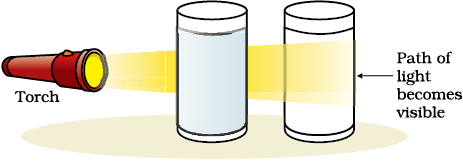
(a) (b)
Fig. 2.3: (a) Solution of copper sulphate does not show
Tyndall effect, (b) mixture of water and milk
shows Tyndall effect.
Tyndall effect can be observed when sunlight passes through the canopy of a dense forest. In the forest, mist contains tiny droplets of water, which act as particles of colloid dispersed in air.
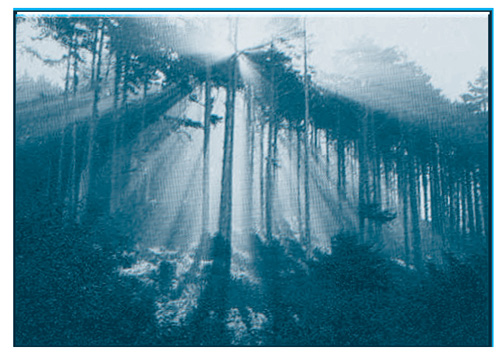
Fig. 2.4: The Tyndall effect
Properties of a colloid
• A colloid is a heterogeneous mixture.
• The size of particles of a colloid is too small to be individually seen by naked eyes.
• Colloids are big enough to scatter a beam of light passing through it and make its path visible.
• They do not settle down when left undisturbed, that is, a colloid is quite stable.
• They cannot be separated from the mixture by the process of filtration. But, a special technique of separation known as centrifugation (perform activity 2.5), can be used to separate the colloidal particles.
The components of a colloidal solution are the dispersed phase and the dispersion medium. The solute-like component or the dispersed particles in a colloid form the dispersed phase, and the component in which the dispersed phase is suspended is known as the dispersing medium. Colloids are classified according to the state (solid, liquid or gas) of the dispersing medium and the dispersed phase. A few common examples are given in Table 2.1. From this table you can see that they are very common everyday life.
Table 2.1: Common examples of colloids
Questions
1. Differentiate between homogen- eous and heterogeneous mixtures with examples.
2. How are sol, solution and suspension different from each other?
3. To make a saturated solution, 36 g of sodium chloride is dissolved in 100 g of water at 293 K. Find its concentration at this temperature.
2.3 Separating the Components of a Mixture
We have learnt that most of the natural substances are not chemically pure. Different methods of separation are used to get individual components from a mixture. Separation makes it possible to study and use the individual components of a mixture.
Heterogeneous mixtures can be separated into their respective constituents by simple physical methods like handpicking, sieving, filtration that we use in our day-to-day life. Sometimes special techniques have to be used for the separation of the components of a mixture.
2.3.1 How can we obtain coloured component (dye) from blue/black ink?
Activity 2.4
• Fill half a beaker with water.
• Put a watch glass on the mouth of the beaker (Fig. 2.5).
• Put few drops of ink on the watch glass.
• Now start heating the beaker. We do not want to heat the ink directly. You will see that evaporation is taking place from the watch glass.
• Continue heating as the evaporation goes on and stop heating when you do not see any further change on the watch glass.
• Observe carefully and record your observations.
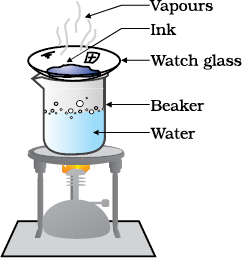
Fig. 2.5: Evaporation
Is Matter Around Us Pure?
Now answer
• What do you think has got evaporated from the watch glass?
• Is there a residue on the watch glass?
• What is your interpretation? Is ink a single substance (pure) or is it a mixture?
We find that ink is a mixture of a dye in water. Thus, we can separate the volatile component (solvent) from its non-volatile solute by the method of evaporation.
2.3.2 How can we separate cream from milk?
Now-a-days, we get full-cream, toned and double-toned varieties of milk packed in poly-packs or tetra packs in the market. These varieties of milk contain different amounts of fat.
Activity 2.5
• Take some full-cream milk in a test tube.
• Centrifuge it by using a centrifuging machine for two minutes. If a centrifuging machine is not available in the school, you can do this activity at home by using a milk churner, used in the kitchen.
• If you have a milk dairy nearby, visit it and ask (i) how they separate cream from milk and (ii) how they make cheese (paneer) from milk.
Now answer
• What do you observe on churning the milk?
• Explain how the separation of cream from milk takes place.
Sometimes the solid particles in a liquid are very small and pass through a filter paper. For such particles the filtration technique cannot be used for separation. Such mixtures are separated by centrifugation. The principle is that the denser particles are forced to the bottom and the lighter particles stay at the top when spun rapidly.
Applications
• Used in diagnostic laboratories for blood and urine tests.
• Used in dairies and home to separate butter from cream.
• Used in washing machines to squeeze out water from wet clothes.
2.3.3 How can we separate a mixture of two immiscible liquids?
Activity 2.6
• Let us try to separate kerosene oil from water using a separating funnel.
• Pour the mixture of kerosene oil and water in a separating funnel (Fig. 2.6).
• Let it stand undisturbed for sometime so that separate layers of oil and water are formed.
• Open the stopcock of the separating funnel and pour out the lower layer of water carefully.
• Close the stopcock of the separating funnel as the oil reaches the stop-cock.
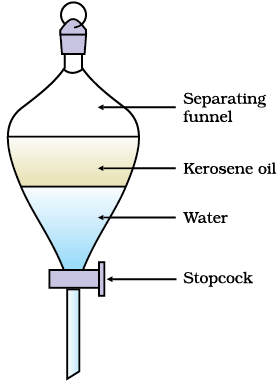
Fig. 2.6: Separation of immiscible liquids
Applications
• To separate mixture of oil and water.
• In the extraction of iron from its ore, the lighter slag is removed from the top by this method to leave the molten iron at the bottom in the furnace.
The principle is that immiscible liquids separate out in layers depending on their densities.
2.3.4 How can we separate a mixture of salt and camphor?
We have learnt in chapter 1 that camphor changes directly from solid to gaseous state on heating. So, to separate such mixtures that contain a sublimable volatile component from a non-sublimable impurity, the sublimation process is used (Fig. 2.7). Some examples of solids which sublime are ammonium chloride, naphthalene and anthracene.
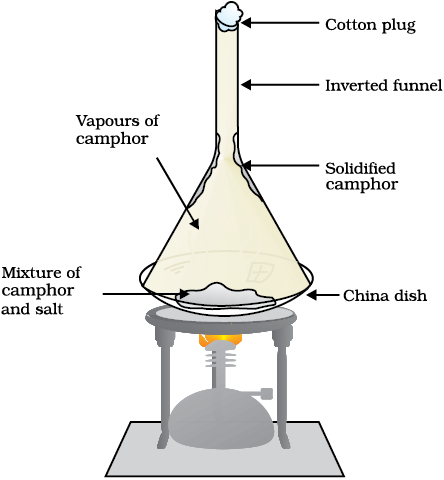
Fig. 2.7: Separation of camphor and salt by sublimation
2.3.5 Is the dye in black ink a single colour?
Activity 2.7
• Take a thin strip of filter paper.
• Draw a line on it using a pencil, approximately 3 cm above the lower edge [Fig. 2.8 (a)].
• Put a small drop of ink (water soluble, that is, from a sketch pen or fountain pen) at the centre of the line. Let it dry.
• Lower the filter paper into a jar/glass/beaker/test tube containing water so that the drop of ink on the paper is just above the water level, as shown in Fig. 2.8(b) and leave it undisturbed.
• Watch carefully, as the water rises up on the filter paper. Record your observations.
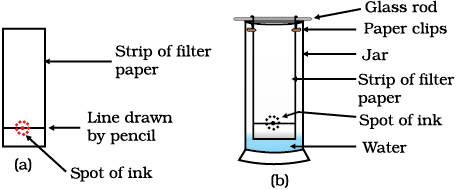
Fig. 2.8: Separation of dyes in black ink using chromatography
Now answer
• What do you observe on the filter paper as the water rises on it?
• Do you obtain different colours on the filter paper strip?
• What according to you, can be the reason for the rise of the coloured spot on the paper strip?
The ink that we use has water as the solvent and the dye is soluble in it. As the water rises on the filter paper it takes along with it the dye particles. Usually, a dye is a mixture of two or more colours. The coloured component that is more soluble in water, rises faster and in this way the colours get separated.
This process of separation of components of a mixture is known as chromatography. Kroma in Greek means colour. This technique was first used for separation of colours, so this name was given. Chromatography is the technique used for separation of those solutes that dissolve in the same solvent.
With the advancement in technology, newer techniques of chromatography have been developed. You will study about chromatography in higher classes.
Applications
To separate
• colours in a dye
• pigments from natural colours
• drugs from blood.
2.3.6 How can we separate a mixture of two miscible liquids?
Activity 2.8
• Let us try to separate acetone and water from their mixture.
• Take the mixture in a distillation flask. Fit it with a thermometer.
• Arrange the apparatus as shown in Fig. 2.9.
• Heat the mixture slowly keeping a close watch at the thermometer.
• The acetone vaporises, condenses in the condenser and can be collected from the condenser outlet.
• Water is left behind in the distillation flask.
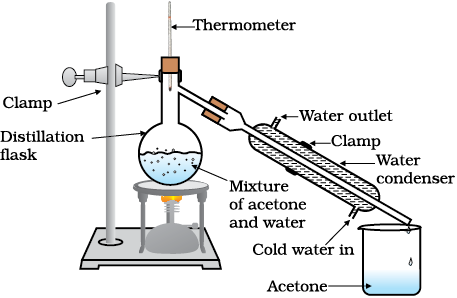
Fig.2.9: Separation of two miscible liquids by distillation
Now answer
• What do you observe as you start heating the mixture?
• At what temperature does the thermometer reading become constant for some time?
• What is the boiling point of acetone?
• Why do the two components separate?
This method is called distillation. It is used for the separation of components of a mixture containing two miscible liquids that boil without decomposition and have sufficient difference in their boiling points.
To separate a mixture of two or more miscible liquids for which the difference in boiling points is less than 25 K, fractional distillation process is used, for example, for the separation of different gases from air, different factions from petroleum products etc. The apparatus is similar to that for simple distillation, except that a fractionating column is fitted in between the distillation flask and the condenser.
A simple fractionating column is a tube packed with glass beads. The beads provide surface for the vapours to cool and condense repeatedly, as shown in Fig. 2.10.

Fig. 2.10: Fractional distillation
2.3.7 How can we obtain different gases from air ?
Air is a homogeneous mixture and can be separated into its components by fractional distillation. The flow diagram (Fig. 2.11) shows the steps of the process.
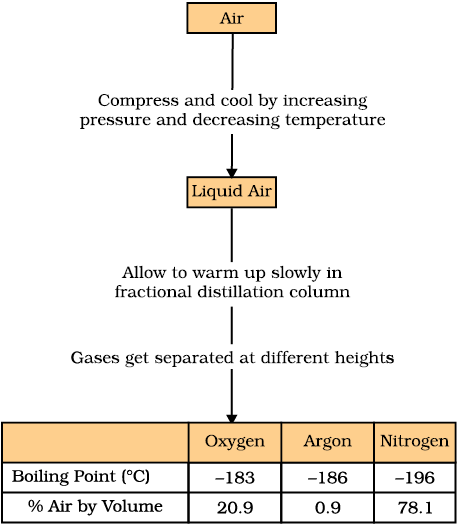
Fig. 2.11: Flow diagram shows the process of obtaining gases from air
If we want oxygen gas from air (Fig. 2.12), we have to separate out all the other gases present in the air. The air is compressed by increasing the pressure and is then cooled by decreasing the temperature to get liquid air. This liquid air is allowed to warm-up slowly in a fractional distillation column, where gases get separated at different heights depending upon their boiling points.
Answer the following:
• Arrange the gases present in air in increasing order of their boiling points.
• Which gas forms the liquid first as the air is cooled?
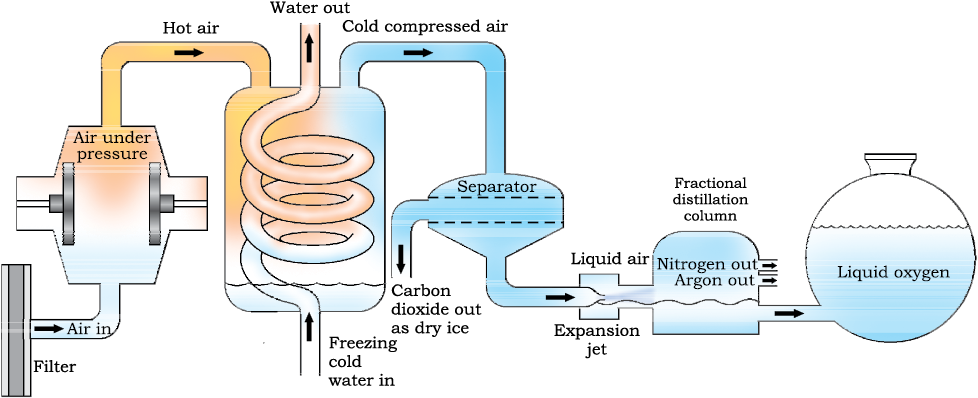
Fig. 2.12: Separation of components of air
2.3.8 How can we obtain pure copper sulphate from an impure sample?
Activity 2.9
• Take some (approximately 5 g) impure sample of copper sulphate in a china dish.
• Dissolve it in minimum amount of water.
• Filter the impurities out.
• Evaporate water from the copper sulphate solution so as to get a saturated solution.
• Cover the solution with a filter paper and leave it undisturbed at room temperature to cool slowly for a day.
• You will obtain the crystals of copper sulphate in the china dish.
• This process is called crystallisation.
Now answer
• What do you observe in the china dish?
• Do the crystals look alike?
• How will you separate the crystals from the liquid in the china dish?
The crystallisation method is used to purify solids. For example, the salt we get from sea water can have many impurities in it. To remove these impurities, the process of crystallisation is used. Crystallisation is a process that separates a pure solid in the form of its crystals from a solution. Crystallisation technique is better than simple evaporation technique as –
• some solids decompose or some, like sugar, may get charred on heating to dryness.
• some impurities may remain dissolved in the solution even after filtration. On evaporation these contaminate the solid.
Applications
• Purification of salt that we get from sea water.
• Separation of crystals of alum (phitkari) from impure samples.
Thus, by choosing one of the above methods according to the nature of the components of a mixture, we get a pure substance. With advancements in technology many more methods of separation techniques have been devised.
In cities, drinking water is supplied from water works. A flow diagram of a typical water works is shown in Fig. 2.13. From this figure write down the processes involved to get the supply of drinking water to your home from the water works and discuss it in your class.

Fig. 2.13: Water purification system in water works
Questions
1. How will you separate a mixture containing kerosene and petrol (difference in their boiling points is more than 25ºC), which are miscible with each other?
2. Name the technique to separate
(i) butter from curd,
(ii) salt from sea-water,
(iii) camphor from salt.
3. What type of mixtures are separated by the technique of crystallisation?
2.4 Physical and Chemical Changes
In the previous chapter, we have learnt about a few physical properties of matter. The properties that can be observed and specified like colour, hardness, rigidity, fluidity, density, melting point, boiling point etc. are the physical properites.
The interconversion of states is a physical change because these changes occur without a change in composition and no change in the chemical nature of the substance. Although ice, water and water vapour all look different and display different physical properties, they are chemically the same.
Both water and cooking oil are liquid but their chemical characteristics are different. They differ in odour and inflammability. We know that oil burns in air whereas water extinguishes fire. It is this chemical property of oil that makes it different from water. Burning is a chemical change. During this process one substance reacts with another to undergo a change in chemical composition. Chemical change brings change in the chemical properties of matter and we get new substances. A chemical change is also called a chemical reaction.
During burning of a candle, both physical and chemical changes take place. Can you distinguish these?
Questions
1. Classify the following as chemical or physical changes:
• cutting of trees,
• melting of butter in a pan,
• rusting of almirah,
• boiling of water to form steam,
• passing of electric current, through water and the water breaking down into hydrogen and oxygen gases,
• dissolving common salt in water,
• making a fruit salad with raw fruits, and
• burning of paper and wood.
2. Try segregating the things around you as pure substances or mixtures.
2.5 What are the Types of Pure Substances?
On the basis of their chemical composition, substances can be classified either as elements or compounds.
2.5.1 Elements
Robert Boyle was the first scientist to use the term element in 1661. Antoine Laurent Lavoisier (1743-94), a French chemist, was the first to establish an experimentally useful definition of an element. He defined an element as a basic form of matter that cannot be broken down into simpler substances by chemical reactions.
Elements can be normally divided into metals, non-metals and metalloids.
Metals usually show some or all of the following properties:
• They have a lustre (shine).
• They have silvery-grey or golden-yellow colour.
• They conduct heat and electricity.
• They are ductile (can be drawn into wires).
• They are malleable (can be hammered into thin sheets).
• They are sonorous (make a ringing sound when hit).
Examples of metals are gold, silver, copper, iron, sodium, potassium etc. Mercury is the only metal that is liquid at room temperature.
Non-metals usually show some or all of the following properties:
• They display a variety of colours.
• They are poor conductors of heat and electricity.
• They are not lustrous, sonorous or malleable.
Examples of non-metals are hydrogen, oxygen, iodine, carbon (coal, coke), bromine, chlorine etc. Some elements have intermediate properties between those of metals and non-metals, they are called metalloids; examples are boron, silicon, germanium etc.
More to know
• The number of elements known at present are more than 100. Ninety-two elements are naturally occurring and the rest are man-made.
• Majority of the elements are solid.
• Eleven elements are in gaseous state at room temperature.
• Two elements are liquid at room temperature–mercury and bromine.
• Elements, gallium and cesium become liquid at a temperature slightly above room temperature (303 K).
2.5.2 Compounds
A compound is a substance composed of two or more elements, chemically combined with one another in a fixed proportion.
What do we get when two or more elements are combined?
Activity 2.10
• Divide the class into two groups. Give 5 g of iron filings and 3 g of sulphur powder in a china dish to both the groups.
Group I
• Mix and crush iron filings and sulphur powder.
Group II
• Mix and crush iron filings and sulphur powder. Heat this mixture strongly till red hot. Remove from flame and let the mixture cool.
Groups I and II
• Check for magnetism in the material obtained. Bring a magnet near the material and check if the material is attracted towards the magnet.
• Compare the texture and colour of the material obtained by the groups.
• Add carbon disulphide to one part of the material obtained. Stir well and filter.
• Add dilute sulphuric acid or dilute hydrochloric acid to the other part of the material obtained.(Note: teacher supervision is necessary for this activity).
• Perform all the above steps with both the elements (iron and sulphur) separately.
Now answer
• Did the material obtained by the two groups look the same?
• Which group has obtained a material with magnetic properties?
• Can we separate the components of the material obtained?
• On adding dilute sulphuric acid or dilute hydrochloric acid, did both the groups obtain a gas? Did the gas in both the cases smell the same or different?
Table 2.2: Mixtures and Compounds
The gas obtained by Group I is hydrogen, it is colourless, odourless and combustible– it is not advised to do the combustion test for hydrogen in the class. The gas obtained by Group II is hydrogen sulphide. It is a colourless gas with the smell of rotten eggs.
You must have observed that the products obtained by both the groups show different properties, though the starting materials were the same. Group I has carried out the activity involving a physical change whereas in case of Group II, a chemical change (a chemical reaction) has taken place.
• The material obtained by group I is a mixture of the two substances. The substances given are the elements– iron and sulphur.
• The properties of the mixture are the same as that of its constituents.
• The material obtained by group II is a compound.
• On heating the two elements strongly we get a compound, which has totally different properties compared to the combining elements.
• The composition of a compound is the same throughout. We can also observe that the texture and the colour of the compound are the same throughout.
Thus, we can summarise the physical and chemical nature of matter in the following graphical organiser :
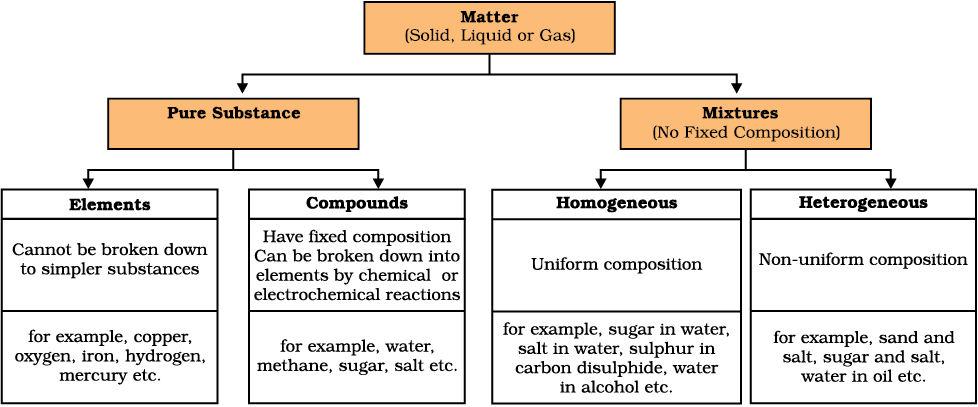
What you have learnt
• A mixture contains more than one substance (element and/or compound) mixed in any proportion.
• Mixtures can be separated into pure substances using appropriate separation techniques.
• A solution is a homogeneous mixture of two or more substances. The major component of a solution is called the solvent, and the minor, the solute.
• The concentration of a solution is the amount of solute present per unit volume or per unit mass of the solution.
• Materials that are insoluble in a solvent and have particles that are visible to naked eyes, form a suspension. A suspension is a heterogeneous mixture.
• Colloids are heterogeneous mixtures in which the particle size is too small to be seen with the naked eye, but is big enough to scatter light. Colloids are useful in industry and daily life. The particles are called the dispersed phase and the medium in which they are distributed is called the dispersion medium.
• Pure substances can be elements or compounds. An element is a form of matter that cannot be broken down by chemical reactions into simpler substances. A compound is a substance composed of two or more different types of elements, chemically combined in a fixed proportion.
• Properties of a compound are different from its constituent elements, whereas a mixture shows the properties of its constituting elements or compounds.
Exercises
1. Which separation techniques will you apply for the separation of the following?
(a) Sodium chloride from its solution in water.
(b) Ammonium chloride from a mixture containing sodium chloride and ammonium chloride.
(c) Small pieces of metal in the engine oil of a car.
(d) Different pigments from an extract of flower petals.
(e) Butter from curd.
(f) Oil from water.
(g) Tea leaves from tea.
(h) Iron pins from sand.
(i) Wheat grains from husk.
(j) Fine mud particles suspended in water.
2. Write the steps you would use for making tea. Use the words solution, solvent, solute, dissolve, soluble, insoluble, filtrate and residue.
3. Pragya tested the solubility of three different substances at different temperatures and collected the data as given below (results are given in the following table, as grams of substance dissolved in 100 grams of water to form a saturated solution).
(a) What mass of potassium nitrate would be needed to produce a saturated solution of potassium nitrate in 50 grams of water at 313 K?
(b) Pragya makes a saturated solution of potassium chloride in water at 353 K and leaves the solution to cool at room temperature. What would she observe as the solution cools? Explain.
(c) Find the solubility of each salt at 293 K. Which salt has the highest solubility at this temperature?
(d) What is the effect of change of temperature on the solubility of a salt?
4. Explain the following giving examples.
(a) saturated solution
(b) pure substance
(c) colloid
(d) suspension
5. Classify each of the following as a homogeneous or heterogeneous mixture.
soda water, wood, air, soil, vinegar, filtered tea.
6. How would you confirm that a colourless liquid given to you is pure water?
7. Which of the following materials fall in the category of a “pure substance”?
(a) Ice
(b) Milk
(c) Iron
(d) Hydrochloric acid
(e) Calcium oxide
(f) Mercury
(g) Brick
(h) Wood
(i) Air.
8. Identify the solutions among the following mixtures.
(a) Soil
(b) Sea water
(c) Air
(d) Coal
(e) Soda water.
9. Which of the following will show “Tyndall effect”?
(a) Salt solution
(b) Milk
(c) Copper sulphate solution
(d) Starch solution.
10. Classify the following into elements, compounds and mixtures.
(a) Sodium
(b) Soil
(c) Sugar solution
(d) Silver
(e) Calcium carbonate
(f) Tin
(g) Silicon
(h) Coal
(i) Air
(j) Soap
(k) Methane
(l) Carbon dioxide
(m) Blood
11. Which of the following are chemical changes?
(a) Growth of a plant
(b) Rusting of iron
(c) Mixing of iron filings and sand
(d) Cooking of food
(e) Digestion of food
(f) Freezing of water
(g) Burning of a candle.
Group Activity
Take an earthen pot (mutka), some pebbles and sand. Design a small-scale filtration plant that you could use to clean muddy water.
